

Fighting slash and burn in Madagascar: African bloggers take action. A hazy response to slash-and-burn. The fire was burning right under our feet through metres of dense peatland.
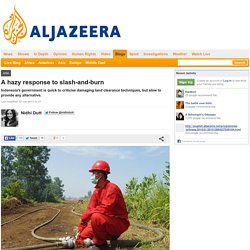
Plumes of smoke pockmarked the widening fire zone in the middle of Pekan Baru in Sumatra. Half a dozen firefighters raced from one smoldering patch to another. Their efforts, severely hampered by few resources, seemed in vein. Just when they appeared to be making progress, the small tank on the back of their fire truck would run out of water. When the tank ran dry firefighters dropped their equipment, unhooked their pipes and dispatched the truck to a nearby water source. As they waited for their truck to return, firefighters put this forest fire into perspective. Local effects Over the past week much has been written, reported and said about the hardships being faced, and inconvenience endured, by Singaporeans and Malaysians as smoky haze from Sumatra’s forest fires drifts across the Straits of Malacca. Clearing land by fire is an annual event in Sumatra.
Slash-and-burn. From Forest to Field: How Fire is Transforming the Amazon : Feature Articles. That is the troubling picture emerging from research by ecologist Daniel Nepstad of the Woods Hole Research Center in Massachusetts and his colleagues in Brazil and the United States, who have been working to identify both the causes and the effects of Amazon fires.
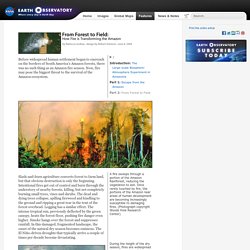
Recently, Nepstad has been a part of the Large-scale Biosphere-Atmosphere Experiment in Amazonia. According to Nepstad, the first accidental burn that steals into the forest is the beginning of a long, downward spiral that compromises forest health over an area equal to or greater than the amount that is deforested outright each year. Slash and burn. Slash and burn (a specific practice that may be part of shifting cultivation or swidden-fallow agriculture) is an agricultural procedure widely used in forested areas.

Although it was practised historically in temperate regions, where it was termed assarting, it is most widely associated with tropical agriculture today. Slash and burn is a specific functional element of certain farming practices, often shifting cultivation systems. In some cases such as parts of Madagascar, slash and burn may have no cyclical aspects (e.g some slash and burn activities can render soils incapable of further yields for generations), or may be practiced on its own as a single cycle farming activity with no follow on cropping cycle.
Rain Forest Threats, Rain Forest Species. More than half of Earth’s rain forests have already been lost forever to the insatiable human demand for wood and arable land.

Rain forests that once grew over 14 percent of the land on Earth now cover only about 6 percent. And if current deforestation rates continue, these critical habitats could disappear from the planet completely within the next hundred years. The reasons for plundering rain forests are mainly economic. Wealthy nations drive demand for tropical timber, and cash-strapped governments often grant logging concessions at a fraction of the land’s true value. “Homesteader” policies also encourage citizens to clear-cut forests for farms. Threats Solutions. Rainforest Concern - Why are they being destroyed? In the past 50 years much of the rainforest in Africa and Asia has been destroyed.
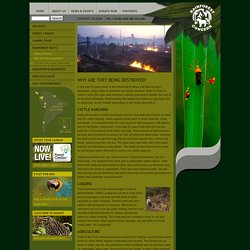
Large areas of rainforest are being cut down, often in order to remove just a few logs, and rainforest is being destroyed at double the rate of all previous estimates. Unfortunately this means that there is a very high rate of extinction, as the wildlife depending on the forest dies with it. Cattle ranching Many rainforests in Central and South America have been burnt down to make way for cattle farming, which supplies cheap beef to North America, China and Russia. It is estimated that for each pound of beef produced, 200 square feet of rainforest is destroyed.
Indigenous Indians also use "slash and burn" farming techniques, but on a small scale. Logging This is believed to be the second largest cause of deforestation. Slash and burn. Saving Lives and Protecting Forests. Slash and Burn Agriculture. Slash and burn agriculture is the process of cutting down the vegetation in a particular plot of land, setting fire to the remaining foliage, and using the ashes to provide nutrients to the soil for use of planting food crops.
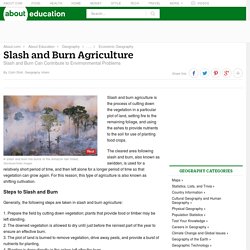
The cleared area following slash and burn, also known as swidden, is used for a relatively short period of time, and then left alone for a longer period of time so that vegetation can grow again. For this reason, this type of agriculture is also known as shifting cultivation. Slash and Burn Agriculture. Slash and burn agriculture is a widely used method of growing food in which wild or forested land is clear cut and any remaining vegetation burned.
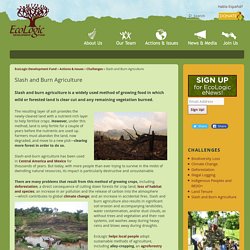
The resulting layer of ash provides the newly-cleared land with a nutrient-rich layer to help fertilize crops. However, under this method, land is only fertile for a couple of years before the nutrients are used up. Farmers must abandon the land, now degraded, and move to a new plot—clearing more forest in order to do so. Api047.pdf. Slash-and-burn.